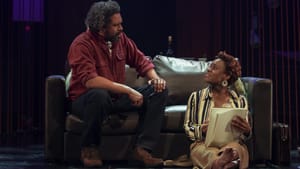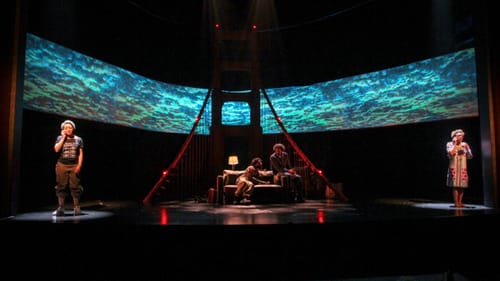Stay in the Loop
BSR publishes on a weekly schedule, with an email newsletter every Wednesday and Thursday morning. There’s no paywall, and subscribing is always free.
Catching sight of a new mission
Philadelphia Theatre Company presents Christina Anderson’s ‘How to Catch Creation’

I wanted to love How to Catch Creation, Philadelphia Theatre Company’s (PTC) last offering of the season, because I love and admire the mission that brought Christina Anderson’s play to the stage of the Suzanne Roberts Theatre.
When Paige Price took the reins at PTC two seasons ago, her plans included a pledge to produce at least one work from the Kilroys List every year. In an effort to combat underrepresentation in theater, a group of playwrights and performers formed the Kilroys in 2013 to promote the work of cisgender women and nonbinary and trans artists of all genders. How to Catch Creation appeared on the 2017 list and received its world premiere at Chicago’s Goodman Theatre earlier this year.
A comeback for PTC?
Price’s commitment represents an important step for PTC, which still needs to define its place in the Philly theater ecosystem after a rough patch that included briefly losing its Avenue of the Arts home space to foreclosure and going dark for much of the 2017-2018 season. Championing the work of emerging, underrepresented voices is essential for the health of the art form and fills a programming gap often missing at major nonprofit companies.
A commitment to the Kilroys is one powerful way for the company to create a distinctive identity, but whether PTC chose the right piece to launch the initiative remains an open question. How to Catch Creation introduces Anderson as a writer of ambition and scope, with its multiple intersecting plot points and two-and-a-half-hour running time. But the strands of story that form this sprawling, multigenerational portrait of Black, queer artistic life in San Francisco often feel underexplored or too neatly resolved. Anderson gestures at the messiness of life, but her play rarely seems authentically untidy in the way it should.
Victorian style
The drama, which shifts back and forth from 1966 to 2014, has the kind of winding design you might expect to find in a Victorian novel. In the past, lesbian novelist G.K. Marche (Tiffani Barbour) tries to balance her literary ambitions and her relationship with Natalie (Shauna Miles), a burgeoning businesswoman. Closer to our current moment, painter Stokes (Jonathan Bangs) and computer whiz Riley (Shayna Small) find themselves absorbed by the legacy of G.K.’s prose. Also in the mix are Tami (Stephanie Weeks) and Griffin (Lindsay Smiling), best friends whose lives unconventionally overlap.
Anderson uses these six people to raise questions about love, determination, monogamy, incarceration, parenthood, redemption, and the present moment’s connection to history. That’s a lot to wrestle with, and occasionally it bears sweet, surprising fruit. Through Griffin, who spent a quarter-century locked up for a crime he didn’t commit, the playwright explores both the injustice of the prison-industrial complex and the sad reality of a world that keeps turning even while you’re not part of it. Smiling beautifully communicates those contradictions in the production’s most fully realized performance.

Foregone conclusions
Yet in other ways, the play falls into overly familiar territory that more closely resembles a clever but facile television drama than a carefully wrought work for the stage. Griffin’s quest to become a father seems more closely focused on defining his relationship to Tami than on creating a legacy to which he can cling. Although Tami identifies as a lesbian, her relationship to Griffin is presented in terms that feel surprisingly heteronormative, with strong romantic overtones.
The dynamics between the two other couples never fully emerge with clarity—in particular, why the go-getting Riley stays with the unmotivated, poseur-like Stokes remains a mystery. When she eventually seeks comfort elsewhere, the choice feels like a foregone conclusion.
The action further includes at least a half-dozen plot twists that could be seen from space, with their obviousness exacerbated by Nataki Garrett’s occasionally plodding direction. More problematically, for a work that strives to put the present in conversation with the past, you rarely sense much thought given to how the world of 1966 evolved into the realities of today.
A worthwhile commitment
Anderson doesn’t ground her story in a sense of place. If it weren’t for Jason Sherwood’s scenic design, which prominently features the Golden Gate Bridge, and Xavier Pierce’s foggy lighting, you might not even realize the San Francisco setting. Similarly, for all of the play’s structural complexity, most of the emotional arcs of the characters seem roughly sketched.
Regrettably, this play about how we make art—and how that art becomes an inheritance for the next generation—has little new to say on the subject. Still, I hope Price will keep her commitment to the Kilroys and make PTC a place where audiences can reliably encounter new voices. Their next season already includes Sarah DeLappe’s The Wolves, which made the 2015 list, and Chelsea Marcantel’s Everything is Wonderful, which received an honorable mention in 2016.
What, When, Where
How to Catch Creation. By Christina Anderson, Nataki Garrett directed. Philadelphia Theatre Company. Through April 14, 2019, at the Suzanne Roberts Theatre, 480 S. Broad Street, Philadelphia. (215) 985-0420 or philadelphiatheatrecompany.org.
The Suzanne Roberts Theatre is an ADA-compliant venue with wheelchair seating in both the orchestra and mezzanine. Patrons with questions about accessible seating can call (215) 985-0420 or email [email protected]. There will be an audio-described performance of How to Catch Creation on Wednesday, April 10, at 1pm, and a sensory-friendly and open-captioned performance on Saturday, April 13, at 2pm.
Sign up for our newsletter
All of the week's new articles, all in one place. Sign up for the free weekly BSR newsletters, and don't miss a conversation.

 Cameron Kelsall
Cameron Kelsall